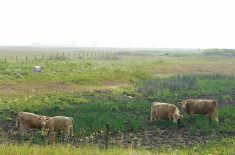Quebec’s provincial ag ministry and the Mauricie regional arm of the Union des producteurs agricoles (UPA) are asking for the public’s patience as they organize a new effort to capture a herd of dairy cattle on the loose since the summer.
Quebec media quoting dairy farmer Pierre Lapointe, the animals’ owner, have said the cattle were spooked by a storm in July when they broke out of their enclosure on his farm at St-Barnabe, about 35 km west of Trois-Rivieres.
The animals have since roamed the neighbouring municipality of St-Severe, where they’ve been seen foraging for food in nearby wooded areas. They’re also believed to have been trampling and grazing on local corn and soybean fields, causing thousands of dollars in crop damage, as well as helping themselves to baled hay in the area.
Read Also

Ample supplies and improved livestock sector to boost Canadian feed sector: FCC
Abundant feed grain supplies and improved profitability for the livestock sector should support strong feed demand and sales through the winter, says a new report from Farm Credit Canada.
Quebec media last week reported on the municipality’s efforts to round up the cattle, at one point enlisting the help of cowboys gathered for an event at St-Tite, about 60 km northeast of St-Severe, but the cattle again escaped capture.
The provincial agriculture ministry (MAPAQ) on Saturday announced it had dispatched a team to the area to work with the municipality and the regional UPA arm on co-ordinating a plan to recover the now-feral cattle without spooking them further.
The Mauricie UPA, in a separate release Monday, said the new “long-term” plan involves using portable feeders to attract the animals, but teams will wait at least a few days for the cattle to adapt to the new routine before moving in to round them up.
Noting recent news coverage of the rogue cattle, UPA said a single co-ordinated and concerted approach is needed to avoid any “multiplication” of efforts by local residents and farmers.
MAPAQ on Saturday said several elements must be considered, such as ensuring the well-being of the animals as well as the safety of the public and motorists, in encouraging the cattle to move to a single mustering area. The ministry described the situation as “exceptional,” adding it could require even further action.
Lapointe, quoted Monday by UPA’s newspaper La terre de chez nous, said there have been a couple of collisions reported in the area in recent weeks involving cattle on the road, but no people have yet been seriously injured.
Ensuring the safety of the animals and public means locating the feeders at a site where the animals are least likely to wander onto public roads, UPA said.
Meanwhile, the ministry has asked the general public not to approach the animals, as such activity could again frighten the cattle and drive them further afield.
Once captured, UPA said, the cattle will be returned to their home farm, where specialists will work to ensure they’re made comfortable. Until then, the organization said, the key word is “patience.”
UPA Mauricie president Martin Marcouiller, in Monday’s release, thanked area farmers for their “solidarity and generosity” in the current recovery effort. — Glacier FarmMedia Network

















